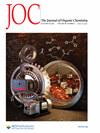2-(1,1-Dicyanomethylene)rhodanine-Functionalized Oligothiophenes: A Structure-Property Investigation of Z/E Photoisomerization Behavior.
IF 3.3
2区 化学
Q1 CHEMISTRY, ORGANIC
引用次数: 0
Abstract
A series of oligothiophenes singly and doubly functionalized with dicyanorhodanine (RCN) units have been investigated to understand their Z/E photoisomerization behavior upon structural modulation. Monotopic RCN target molecules (1-Z-9-Z) were designed to observe the consequences of π-conjugation, solubilizing group substitution, and formylation of the thiophene units. In all cases, the Z isomer is obtained from synthesis as the thermodynamically stable isomer, whereas the E isomer is achieved through selective irradiation (including red light, λirr = 628 nm) as a Z/E mixture in solution. For the quarterthiophene entries, photoisomerization is inhibited, with photoirradiation resulting only in degradation. The result comports with concentration-dependent studies, which show that increasing π-conjugation results in greater aggregation and muted Z/E photoisomerization. Ditopic RCN targets (10-ZZ-12-ZZ), mimicking acceptor-donor-acceptor (A-D-A) oligomers relevant to OPV materials, also show evidence of photoisomerization in solution, with formation of Z,Z/Z,E mixtures at the photostationary state (PSS). Complementary ground- and excited-state DFT calculations show excellent agreement with the experimental findings. This comprehensive structure-property analysis is expected to both guide and caution the functional materials community with respect to the usage of photoisomerizable RCN-oligothiophenes for optoelectronic applications.2-(1,1-二氰基亚甲基)罗丹宁官能化低聚噻吩:Z/E 光异构化行为的结构-性质研究。
我们研究了一系列用双氰基十二烷(RCN)单元单官能化和双官能化的低聚噻吩,以了解它们在结构调整时的 Z/E 光异构化行为。设计了单配位 RCN 目标分子(1-Z-9-Z),以观察噻吩单元的 π 键合、增溶基团取代和甲酰化的后果。在所有情况下,Z 异构体都是通过合成获得的热力学稳定异构体,而 E 异构体则是通过选择性照射(包括红光,λirr = 628 纳米)在溶液中形成的 Z/E 混合物。对于四分之一噻吩条目,光异构化受到抑制,光照射只会导致降解。这一结果与浓度依赖性研究相吻合,浓度依赖性研究表明,π-共轭度的增加会导致更大的聚集和 Z/E 光异构化的减弱。二配位 RCN 目标物(10-ZZ-12-ZZ)模仿了与 OPV 材料相关的受体-供体-受体(A-D-A)低聚物,也显示出溶液中光异构化的证据,在光静止态(PSS)形成 Z,Z/Z,E 混合物。互补的基态和激发态 DFT 计算显示与实验结果非常吻合。这一全面的结构-性能分析有望为功能材料界在光电应用中使用可光异构化的 RCN-寡噻吩提供指导和警示。
本文章由计算机程序翻译,如有差异,请以英文原文为准。
求助全文
约1分钟内获得全文
求助全文
来源期刊

The Journal of Organic Chemistry
化学-有机化学
CiteScore
6.20
自引率
11.10%
发文量
1467
审稿时长
2 months
期刊介绍:
The Journal of Organic Chemistry welcomes original contributions of fundamental research in all branches of the theory and practice of organic chemistry. In selecting manuscripts for publication, the editors place emphasis on the quality and novelty of the work, as well as the breadth of interest to the organic chemistry community.
 求助内容:
求助内容: 应助结果提醒方式:
应助结果提醒方式:


